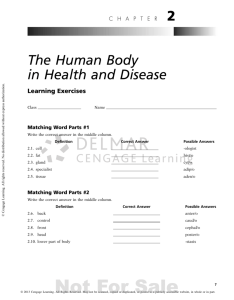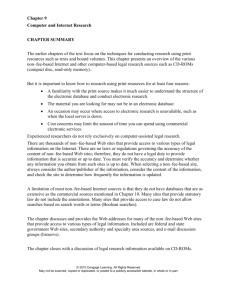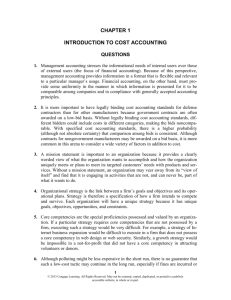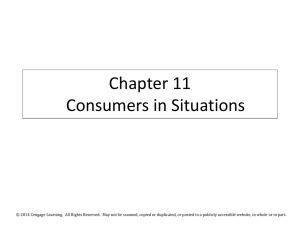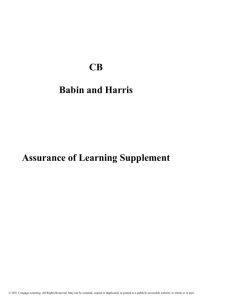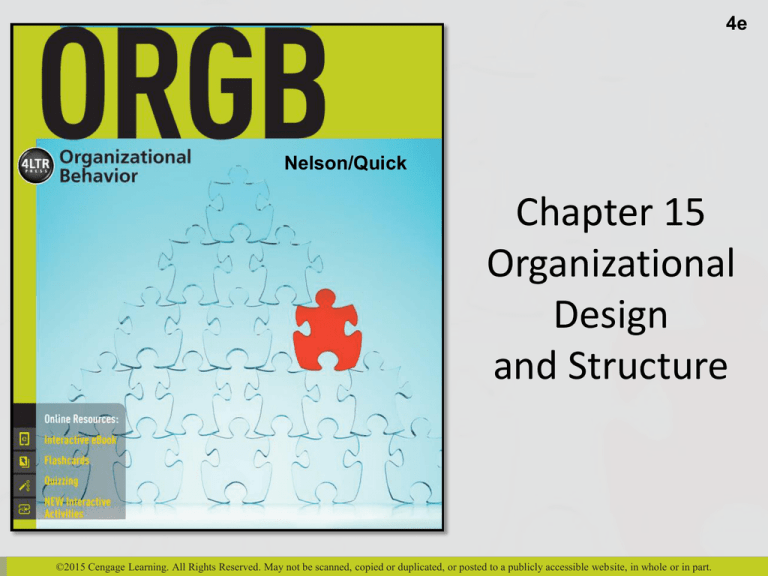
4e
Nelson/Quick
Chapter 15
Organizational
Design
and Structure
©2015 Cengage Learning. All Rights Reserved. May not be scanned, copied or duplicated, or posted to a publicly accessible website, in whole or in part.
Learning Outcomes
Define differentiation and integration as
organizational design processes
Discuss the basic design dimensions managers must
consider in structuring an organization
Describe five structural configurations for
organizations
Describe four contextual variables that influence
organizational structure
©2015 Cengage Learning. All Rights Reserved. May not be scanned, copied or duplicated, or posted to a publicly accessible website, in whole or in part.
2
Learning Outcomes
Explain the forces reshaping organizations
Identify and describe emerging organizational
structures
Identify factors that can adversely affect
organizational structure
©2015 Cengage Learning. All Rights Reserved. May not be scanned, copied or duplicated, or posted to a publicly accessible website, in whole or in part.
3
Organizational Design and Structure
Organizational design
• The process of constructing and adjusting an
organization’s structure to achieve its business
strategy and goals
Organizational structure
• The linking of departments and jobs within an
organization
©2015 Cengage Learning. All Rights Reserved. May not be scanned, copied or duplicated, or posted to a publicly accessible website, in whole or in part.
4
Learning Outcome
Define differentiation and integration as
organizational design processes
©2015 Cengage Learning. All Rights Reserved. May not be scanned, copied or duplicated, or posted to a publicly accessible website, in whole or in part.
5
Key Organizational Design Processes
Differentiation: Deciding how to divide the work in
an organization
Dimensions
Manager’s goal orientation
Time orientation
Interpersonal orientation
Formality of structure
©2015 Cengage Learning. All Rights Reserved. May not be scanned, copied or duplicated, or posted to a publicly accessible website, in whole or in part.
6
Types of Differentiation
Horizontal
• Degree of differentiation between organizational subunits
Vertical
• Difference in authority and responsibility in the
organizational hierarchy
Spatial
• Geographic dispersion of an organization’s offices, plants,
and personnel
©2015 Cengage Learning. All Rights Reserved. May not be scanned, copied or duplicated, or posted to a publicly accessible website, in whole or in part.
7
Beyond the Book:
Differentiation at Cisco
• At Cisco, the existence of multiple teams, councils,
boards, and working groups within Cisco creates a web
of internal integrating structures that lead to fast
decisions by the right people to ensure that the company
is agile
• Cisco has a complex organizational structure because it
allows the firm to enter into new markets quickly
• An emphasis on horizontal integration and cross-function
teaming allows Cisco to be much more agile than before.
A key benefit is speed in decision making
©2015 Cengage Learning. All Rights Reserved. May not be scanned, copied or duplicated, or posted to a publicly accessible website, in whole or in part.
8
Key Organizational Design Processes
Integration: Coordinating the different parts of an
organization
Supports dynamic equilibrium, in which all the parts
of an organization are interrelated and balanced
©2015 Cengage Learning. All Rights Reserved. May not be scanned, copied or duplicated, or posted to a publicly accessible website, in whole or in part.
9
Integration
Vertical integration
• Hierarchical referral
• Rules and procedures
• Plans and schedules
• Positions added to the
organization structure
• Management
information systems
Horizontal integration
• Liaison roles
• Task forces
• Integrator positions
• Teams
©2015 Cengage Learning. All Rights Reserved. May not be scanned, copied or duplicated, or posted to a publicly accessible website, in whole or in part.
10
Learning Outcome
Discuss the basic design dimensions
managers must consider in structuring an
organization
©2015 Cengage Learning. All Rights Reserved. May not be scanned, copied or duplicated, or posted to a publicly accessible website, in whole or in part.
11
Two Ways to Approach the
Organizational Design Process
Establish desired level of each structural dimension
on a high-low continuum and develop structure that
meets desired configuration
Describe what is or is not important to the success
of the organization
©2015 Cengage Learning. All Rights Reserved. May not be scanned, copied or duplicated, or posted to a publicly accessible website, in whole or in part.
12
Structural Dimensions
Formalization
• Degree to which the organization has official rules,
regulations, and procedures
Centralization
• Degree to which decisions are made at the top of the
organization
Specialization
• Degree to which jobs are narrowly defined and depend on
unique expertise
©2015 Cengage Learning. All Rights Reserved. May not be scanned, copied or duplicated, or posted to a publicly accessible website, in whole or in part.
13
Structural Dimensions
Standardization
• Degree to which work activities are accomplished in a routine
fashion
Complexity
• Degree to which many different types of activities occur in the
organization
Hierarchy of authority
• Degree of vertical differentiation across levels of management
©2015 Cengage Learning. All Rights Reserved. May not be scanned, copied or duplicated, or posted to a publicly accessible website, in whole or in part.
14
Learning Outcome
Describe five structural configurations for
organizations
©2015 Cengage Learning. All Rights Reserved. May not be scanned, copied or duplicated, or posted to a publicly accessible website, in whole or in part.
15
Table 15.1 - Five Structural
Configurations of Organization
©2015 Cengage Learning. All Rights Reserved. May not be scanned, copied or duplicated, or posted to a publicly accessible website, in whole or in part.
16
Figure 15.2 - Five Basic Parts of an
Organization
©2015 Cengage Learning. All Rights Reserved. May not be scanned, copied or duplicated, or posted to a publicly accessible website, in whole or in part.
17
Learning Outcome
Describe four contextual variables that
influence organizational structure
©2015 Cengage Learning. All Rights Reserved. May not be scanned, copied or duplicated, or posted to a publicly accessible website, in whole or in part.
18
Contextual Variables
Set of characteristics that influences the
organization’s design processes
Size
Technology
Strategy and goals
Environment
©2015 Cengage Learning. All Rights Reserved. May not be scanned, copied or duplicated, or posted to a publicly accessible website, in whole or in part.
19
Size
Measured in number of employees
Formalization, specialization and standardization
greater in larger organizations
Size increases, complexity increases
©2015 Cengage Learning. All Rights Reserved. May not be scanned, copied or duplicated, or posted to a publicly accessible website, in whole or in part.
20
Technology
Tools, techniques, and actions used by an
organization to transform inputs into outputs
Different departments employ different technologies
Types
Unit - Small batch manufacturing technology
Mass - Large-batch manufacturing technology
and made-to-order production
Process production - Continuous-production
process
©2015 Cengage Learning. All Rights Reserved. May not be scanned, copied or duplicated, or posted to a publicly accessible website, in whole or in part.
21
Technology
Technological interdependence: Degree of
interrelatedness of the organization’s various
technological elements
James Thompson’s research suggests greater
technological interdependence leads to greater
complexity
©2015 Cengage Learning. All Rights Reserved. May not be scanned, copied or duplicated, or posted to a publicly accessible website, in whole or in part.
22
Figure 15.3 - Summary of Perrow’s
Findings
©2015 Cengage Learning. All Rights Reserved. May not be scanned, copied or duplicated, or posted to a publicly accessible website, in whole or in part.
23
Environment
Anything outside the boundaries of an
organization
Task environment: Part of the environment that is
directly relevant to the organization
Environmental uncertainty: Amount and rate of
change in the organization’s environment
©2015 Cengage Learning. All Rights Reserved. May not be scanned, copied or duplicated, or posted to a publicly accessible website, in whole or in part.
24
Extremes of Environmental
Uncertainty
Mechanistic structure: Organizational design that
emphasizes structured activities, specialized tasks,
and centralized decision making
Organic structure: Organizational design that
emphasizes teamwork, open communication, and
decentralized decision making
©2015 Cengage Learning. All Rights Reserved. May not be scanned, copied or duplicated, or posted to a publicly accessible website, in whole or in part.
25
Strategy and Goals
Provide legitimacy to the organization, employee
direction, decision guidelines, and criteria for
performance
Help the organization fit into its environment
Limitations
Changing the organization’s structure drives up costs
and difficulties
Inefficiency of the structure to perceive
environmental changes can lead to organizational
failure
©2015 Cengage Learning. All Rights Reserved. May not be scanned, copied or duplicated, or posted to a publicly accessible website, in whole or in part.
26
Relationships Among
Organizational Design Elements
Context of the
organization
Influences how managers perceive structural needs
Structural Dimensions
Differentiation and
Integration
Which characterize the
organizational processes
Which influence
how well the
structure meets
its
Which influence how well the structure fits the
Purposes
Context of the
organization
©2015 Cengage Learning. All Rights Reserved. May not be scanned, copied or duplicated, or posted to a publicly accessible website, in whole or in part.
27
Learning Outcome
Explain the forces reshaping organizations
©2015 Cengage Learning. All Rights Reserved. May not be scanned, copied or duplicated, or posted to a publicly accessible website, in whole or in part.
28
Forces Reshaping Organizations
Organizational life
cycles
Globalization
Changes in
informationprocessing
technologies
Demands on
organizational
processes
©2015 Cengage Learning. All Rights Reserved. May not be scanned, copied or duplicated, or posted to a publicly accessible website, in whole or in part.
29
Learning Outcome
Identify and discuss emerging organizational
structures
©2015 Cengage Learning. All Rights Reserved. May not be scanned, copied or duplicated, or posted to a publicly accessible website, in whole or in part.
30
Figure 15.5 - Harley-Davidson’s Circle
Organization
©2015 Cengage Learning. All Rights Reserved. May not be scanned, copied or duplicated, or posted to a publicly accessible website, in whole or in part.
31
Emerging Structures
Network organizations
• Web-like structures that contract some or all operations to
other organizations and then coordinate activities
Virtual organizations
• Temporary networks of organizations consisting of
independent enterprises
Circle organizations
• Open system, organic structure for customer responsiveness
©2015 Cengage Learning. All Rights Reserved. May not be scanned, copied or duplicated, or posted to a publicly accessible website, in whole or in part.
32
Learning Outcome
Identify factors that can adversely affect
organizational structure
©2015 Cengage Learning. All Rights Reserved. May not be scanned, copied or duplicated, or posted to a publicly accessible website, in whole or in part.
33
Four Symptoms of Structural
Weakness
Delay in decision making
Poor quality decision making
Lack of innovative response to changing
environment
High level of conflict
©2015 Cengage Learning. All Rights Reserved. May not be scanned, copied or duplicated, or posted to a publicly accessible website, in whole or in part.
34
Dysfunctional Personality/Organization
Combinations
Paranoid
Depressive
Compulsive
Dramatic
Schizoid
©2015 Cengage Learning. All Rights Reserved. May not be scanned, copied or duplicated, or posted to a publicly accessible website, in whole or in part.
35
Rendition
Review the section, “Basic Design Dimensions.”
Which dimensions does this scene show or imply?
Can you sense the division of labor represented by
Senator Hawkins and Alan Smith? Corrine Whitman
does not appear in this scene but is also part of a
division of labor
Review the five structural configurations described
in the chapter. Which of those configurations best
describes the likely structure of Senator Hawkins’
office? Which configurations do not apply? Why?
©2015 Cengage Learning. All Rights Reserved. May not be scanned, copied or duplicated, or posted to a publicly accessible website, in whole or in part.
36
Modern Shed
How did Ryan Smith determine whether his
company needed a mechanistic structure with a tall
vertical hierarchy or an organic one involving freeflowing partnerships?
What are the advantages and disadvantages of
Modern Shed’s organizational structure?
Give an example of how Modern Shed’s structure
enables fast response to rapidly changing market
opportunities
©2015 Cengage Learning. All Rights Reserved. May not be scanned, copied or duplicated, or posted to a publicly accessible website, in whole or in part.
37



